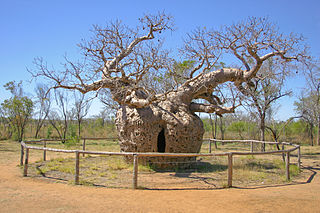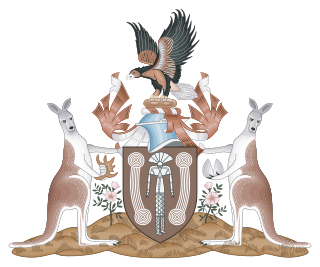| Wangga | |
|---|---|
| Stylistic origins | Traditional music |
| Cultural origins | Aboriginal Australian |
| Typical instruments | Indigenous Australian instruments |
Wangga (sometimes spelled Wongga) is an Aboriginal Australian genre of traditional music and ceremony which originated in Northern Territory and north Western Australia. Specifically, from South Alligator River south east towards Ngukurr, south to the Katherine and west into the Kimberley. [1] The Yolngu peoples of Arnhem Land created the genre.
In 1938, Australian anthropologist A. P. Elkin described Wangga, "[It] starts as a sudden high note, then descends in regular intervals to a low pitch, after which the songman just beats his sticks to the accompaniment of the didgeridoo. Twenty seconds or more later, the melody is sung as before and so on" and lyrics tend to be syllables. [2] Typically, the songs and dances express themes related to death and regeneration. [3] The songs are performed publicly. The singers compose from their daily lives or while dreaming of a nyuidj (dead spirit). [4]
Summary: Children singing; origin of Murinbata moieties; other myths; subsection system; ceremonial singing and discussion; Daly River wangga singing.
Summary: Murrinhpatha narratives of culture heroes and other important figures; songs accompanying the narratives; Wangga and Lirrga singing; Port Keats mission history; oral history;
Balga, wangga and lirrga songs; song cycles belonging to individuals
Collection includes Guwamu or Murawari songs, Wangga-Yutjuru songs, Margany corroboree song
Basic word lists, verbs, sentences; comparison of light and heavy Kriol; Ngalkbon in comparison with Kriol; myths including emu; children's songs-traditional and non-indigenous; wangga and other traditional songs
Summary: Circumcision ceremony; wangga (wonga) and thanpa (tchamba); Murrinpahpatha song genres Thanpa, Malkarrin and Wurlthirri; Marri Ngarr song genre Lirrga; church and liturgical music in traditional song style; language discussion and stories; Boniface's ordination; Easter and Xmas services; Bathurst and Port Keats choirs; modern and country music; local band concerts; wartime music from commercial recording.
Summary: Wangga ceremony songs, sung by Turkey Creek singers at Mowanjum.
Summary: Walungari, Wurrngannjin and Wangga songs, recorded during filming.

Indigenous music of Australia comprises the music of the Aboriginal and Torres Strait Islander peoples of Australia, intersecting with their cultural and ceremonial observances, through the millennia of their individual and collective histories to the present day. The traditional forms include many aspects of performance and musical instrumentation that are unique to particular regions or Aboriginal Australian groups; and some elements of musical tradition are common or widespread through much of the Australian continent, and even beyond. The music of the Torres Strait Islanders is related to that of adjacent parts of New Guinea. Music is a vital part of Indigenous Australians' cultural maintenance.

Derby is a town in the Kimberley region of Western Australia. At the 2016 census, Derby had a population of 3,325 with 47.2% of Aboriginal and Torres Strait Islander descent. Along with Broome and Kununurra, it is one of only three towns in the Kimberley to have a population over 2,000. Located on King Sound, Derby has the highest tides in Australia, with the differential between low and high tide reaching 11.8 metres (39 ft).
Wadeye is a town in Australia's Northern Territory (NT). It was formerly known as Port Keats, a name originating from Port Keats Mission, which operated from 1935 until 1978. In the last few years, Port Keats was run as an Aboriginal reserve by the Northern Territory Government, before being renamed Wadeye when control was passed to the Kardu Numida Council.

The Murrinh-Patha, or Murinbata, are an Aboriginal Australian people of the Northern Territory.
Australian Kriol also known as Roper River Kriol, Fitzroy Valley Kriol, Northern Australian Creole or Aboriginal English is an English-based creole language that developed from a pidgin used initially in the region of Sydney and Newcastle in New South Wales, Australia, in the early days of European colonisation. Later, it was spoken by groups further west and north. The pidgin died out in most parts of the country, except in the Northern Territory, where the contact between European settlers, the Chinese and other Asians, and the Aboriginal Australians in the northern regions has maintained a vibrant use of the language, which is spoken by about 30,000 people. Despite its similarities to English in vocabulary, it has a distinct syntactic structure and grammar. It is a language in its own right and is distinct from Torres Strait Creole.
The Garma Festival of Traditional Cultures (Garma) is Australia's largest Indigenous cultural gathering, taking place over four days each August in northeast Arnhem Land, in the Northern Territory, Australia. Hosted by the Yothu Yindi Foundation, Garma is a celebration of the cultural traditions of the Yolngu people, and a major community gathering for the clans and families of the Arnhem Land region. The event showcases traditional miny'tji (art), ancient story-telling, manikay (song), and bunggul (dance). It is held at Gulkula, a significant Gumatj ceremonial site about 40 kilometres (25 mi) from the township of Nhulunbuy, attracts more than 2500 guests each year and is often sold out months in advance.
William Edward Hanley Stanner CMG, often cited as W.E.H. Stanner, was an Australian anthropologist who worked extensively with Indigenous Australians. Stanner had a varied career that also included journalism in the 1930s, military service in World War II, and political advice on colonial policy in Africa and the South Pacific in the post-war period.
Australian Aboriginal culture includes a number of practices and ceremonies centered on a belief in the Dreamtime and other mythology. Reverence and respect for the land and oral traditions are emphasised. Over 300 languages and other groupings have developed a wide range of individual cultures. Due to the colonization of Australia under terra nullius concept these cultures were treated as one monoculture. Australian Aboriginal art has existed for thousands of years and ranges from ancient rock art to modern watercolour landscapes. Aboriginal music has developed a number of unique instruments. Contemporary Australian Aboriginal music spans many genres. Aboriginal peoples did not develop a system of writing before colonisation, but there was a huge variety of languages, including sign languages.

The Local Court of the Northern Territory is one of two levels of court in the Northern Territory of Australia. It has jurisdiction in civil disputes up to A$250,000, and in criminal cases in the trial of summary offences, and also deals with preliminary matters for indictable offences which are then heard by the Supreme Court of the Northern Territory. There are local courts held in Darwin, Alice Springs, Katherine, Tennant Creek, and some "bush courts" in remote locations.

Drysdale River is a river in the Kimberley region of Western Australia.
Shellie Morris is an Indigenous Australian singer/songwriter who plays a mix of contemporary folk music and contemporary acoustic ballads.
Ngukurr, formerly Roper River Mission (1908−1968), is a remote Aboriginal community on the banks of the Roper River in southern Arnhem Land, Northern Territory.
The Marrithiyal, also written Marrithiel, are an Aboriginal Australian people whose traditional territory lay 100 to 130 miles south of Darwin from Litchfield National Park and extend to the Daly River in the Northern Territory. They are also known as the Berringen people to represent their affiliation and deep connections across the neighbouring South Western Daly region.

The Worrorra, also written Worora, are an Aboriginal Australian people of the Kimberley area of north-western Australia.
The Warndarrang people, (waɳʈaraŋ), also spelt Warndarang, Wanderang, and other variants were a predominantly coastal Aboriginal Australian people of eastern Northern Territory. Though extinct as a distinct ethnolinguistic group, their descendants survive among the neighbouring Nunggubuyu.
Kathleen Mary Mills, also known as Mooradoop and Aunty Kathy, was an Australian community leader, singer, Aboriginal elder and activist in the Northern Territory of Australia. She had a large family, all musical, with several of her daughters being well known as the Mills Sisters.
Felicity Meakins is a linguist specialising in Australian Indigenous languages, morphology and language contact, who was one of the first academics to describe Gurindji Kriol. As of 2022, she is a professor at the University of Queensland and Deputy Director of the University of Queensland node of the Australian Research Council (ARC) Centre of Excellence for the Dynamics of Language. She holds an ARC Future Fellowship focusing on language evolution and contact processes across northern Australia.
The Wadjiginy, also referred to historically as the Wogait, are an indigenous Australian people of the Northern Territory, specifically from just north of modern-day Darwin. The Wadjiginy are a saltwater people who describe themselves as wagatj 'beach-dwellers' from the Batjamalh word wagatj 'beach'.
Aviair Pty Ltd, previously known as Slingair Heliwork, is an airline and air charter company based in Kununurra, Western Australia. It is a wholly owned subsidiary of HM Consolidated Pty Ltd. It operates air charter services and regular passenger services. Its main bases are Kununurra Airport, Broome International Airport and Karratha Airport.
Linda Mary Barwick is an Australian musicologist and professor emeritus at the Sydney Conservatorium of Music. Barwick has focused on researching Australian Indigenous music and the music of immigrant communities. She also works in the field of digital humanities, archiving recordings.